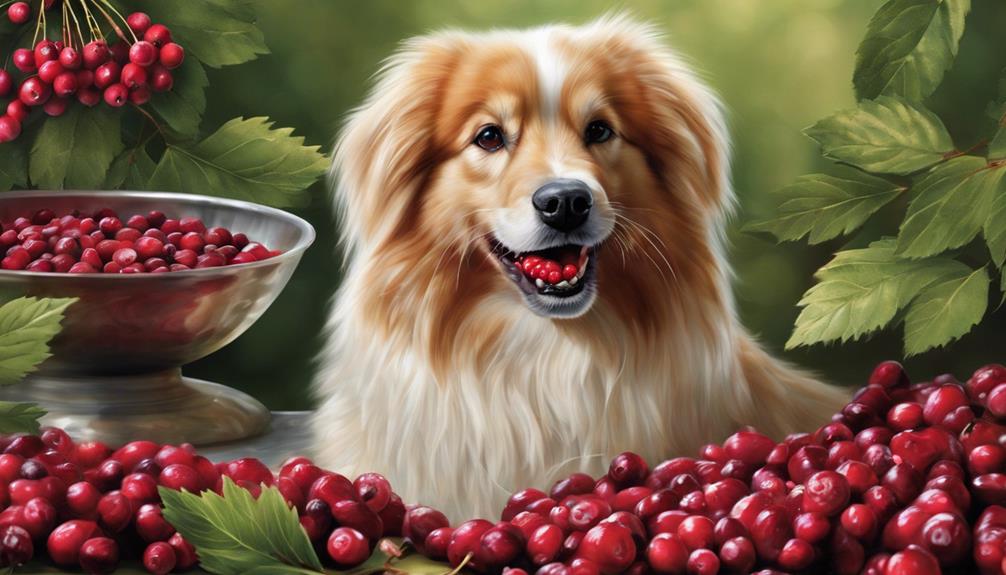Yes, dogs can eat cranberries safely. However, some precautions are important to keep them healthy. Cranberry sauce high in sugar and toxic ingredients like grapes or alcohol can be harmful. Too many cranberries can cause digestive upset and kidney issues, so it's best to check with a vet first. Cranberries are believed to prevent UTIs by stopping bacteria from sticking to the bladder. The correct dosage is essential for UTI prevention, and vets can help manage this. If you want to know more about feeding cranberries to dogs, we have additional detailed information available.
Key Takeaways
- Consult a vet before feeding cranberries.
- Avoid high-sugar cranberry sauce.
- Watch for toxic ingredients like grapes.
- Moderation prevents digestive upset and kidney issues.
- Cranberries can support urinary tract health in dogs.
Potential Risks of Feeding Cranberries to Dogs
In addition, cranberry sauce, often enjoyed during holidays, isn't suitable for dogs due to its high sugar content and potential toxic ingredients like grapes or alcohol. Excessive consumption of cranberries can lead to various health risks in dogs, such as digestive upset or even kidney issues.
It's important to always feed cranberries to your furry friend in moderation and seek veterinary advice before introducing them into their diet. If you're looking for safer alternatives, consider offering your dog fruits and vegetables that pose fewer risks to their health.
Cranberries Vs. UTIS in Dogs
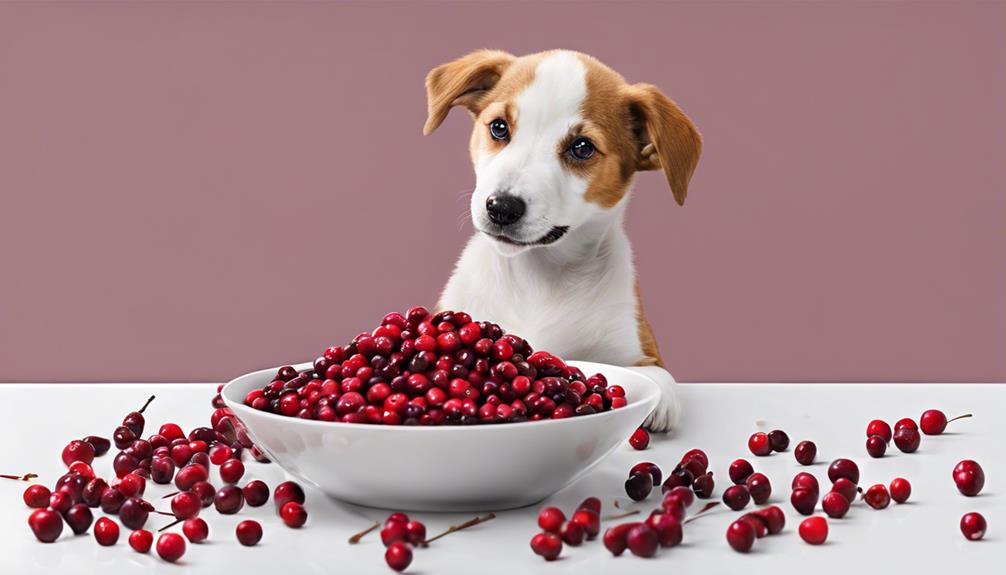
Cranberries are believed to aid in preventing urinary tract infections in dogs because of components that can prevent bacteria from adhering in the urinary tract.
It's important to consult a vet before providing cranberries to manage UTIs in dogs and monitor for any adverse reactions.
Understanding the correct dosage and potential benefits of cranberries for UTI prevention is essential for your furry friend's health.
UTI Prevention With Cranberries
When considering urinary tract infection prevention for dogs, the importance of using cranberries as a supplement is still being studied. Cranberries are believed to help prevent UTIs in dogs due to compounds that can inhibit bacteria from sticking to the bladder wall.
While research on cranberries for UTIs in dogs is limited, they're commonly used to support urinary tract health. It's vital to consult a veterinarian before using cranberries for UTI prevention in dogs as individual responses may vary. Cranberries should be seen as a complementary measure, not a replacement for proper medical treatment.
Monitoring your dog for any adverse effects when introducing cranberries into their diet for UTI prevention is essential for their overall well-being.
Cranberry Dosage for Dogs
When considering urinary tract infection prevention for dogs with cranberries, it's important to determine the appropriate dosage for their size. The recommended cranberry dosage for dogs is 1 tablespoon of cranberry sauce or dried cranberries per 20 pounds of body weight.
Cranberries contain compounds that may help prevent urinary tract infections (UTIs) in dogs by inhibiting bacteria from adhering to the bladder wall. While cranberries can be beneficial for UTIs in dogs, they should be used as a supplement to veterinary treatment rather than a key solution.
It's essential to consult with a vet before introducing cranberries to manage UTIs in dogs, as individual cases may vary in treatment needs. Monitoring your dog for any adverse effects when incorporating cranberries for UTI management is critical for their overall health and well-being.
Monitoring Dogs After Cranberry Consumption
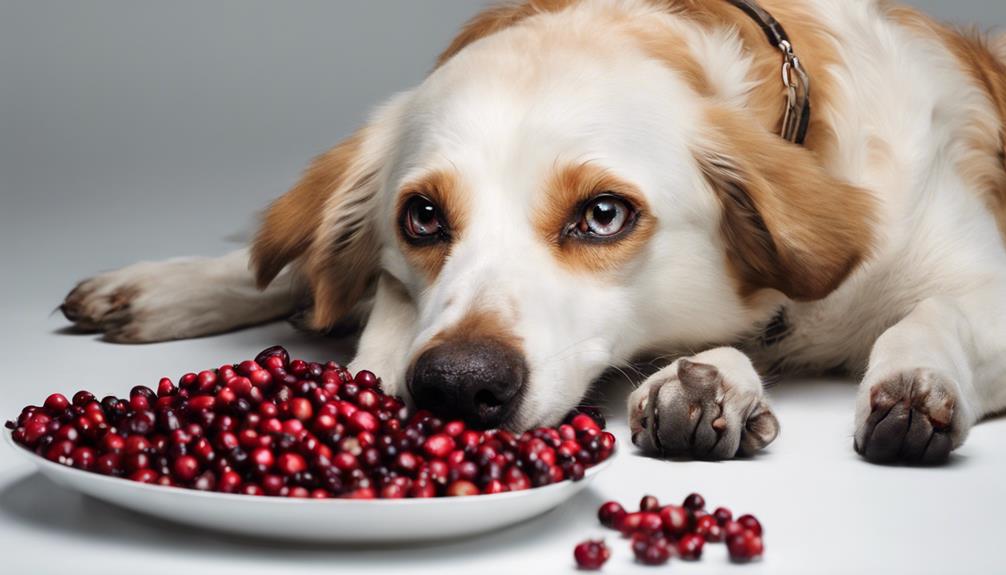
When your dog eats cranberries, it's important to keep an eye out for any possible reactions. Look for signs like itching, swelling, or difficulty breathing which could indicate an allergy.
Also, observe your dog for any digestive issues such as vomiting or diarrhea that may occur after consuming cranberries.
Watch for Allergies
Keeping a close eye on our furry companions for any signs of allergic reactions like itching, swelling, or hives is essential after they have consumed cranberries. To help you understand better, here is a table showing symptoms of allergic reactions in dogs post-cranberry ingestion:
| Allergic Reaction Symptoms | Description |
|---|---|
| Itching | Scratching or biting at skin |
| Swelling | Visible puffiness or enlargement |
| Hives | Raised, red welts on the skin |
Check for Digestive Upset
After watching out for allergic reactions, it's important to monitor our dogs for signs of digestive upset following their consumption of cranberries. We should keep an eye out for symptoms like vomiting, diarrhea, or excessive gas, which could indicate digestive issues. Changes in stool consistency or frequency might also signal a problem.
Observing our dog's behavior is essential; any signs of discomfort, lethargy, or unusual reactions after eating cranberries should be noted. If there are indications of abdominal pain or discomfort, it's vital to assess their well-being.
If any persistent or severe digestive upset is observed, consulting with a veterinarian is recommended to address potential health concerns promptly.
Monitor Urinary Changes
We should closely observe our dogs' urinary habits for any changes in frequency or color following their consumption of cranberries. Keep an eye out for signs of discomfort or straining during urination post-cranberry consumption.
If you notice increased water intake or more frequent urination, it could indicate a reaction to cranberries affecting the urinary tract. Monitoring these changes is vital to assess the impact of cranberries on your dog's urinary health.
If you observe any unusual behavior or urinary issues in your dog after feeding them cranberries, it's important to consult a vet promptly. By tracking urinary changes, you can better understand how cranberries may be influencing your dog's overall well-being.
Cranberries for Dental Health in Dogs
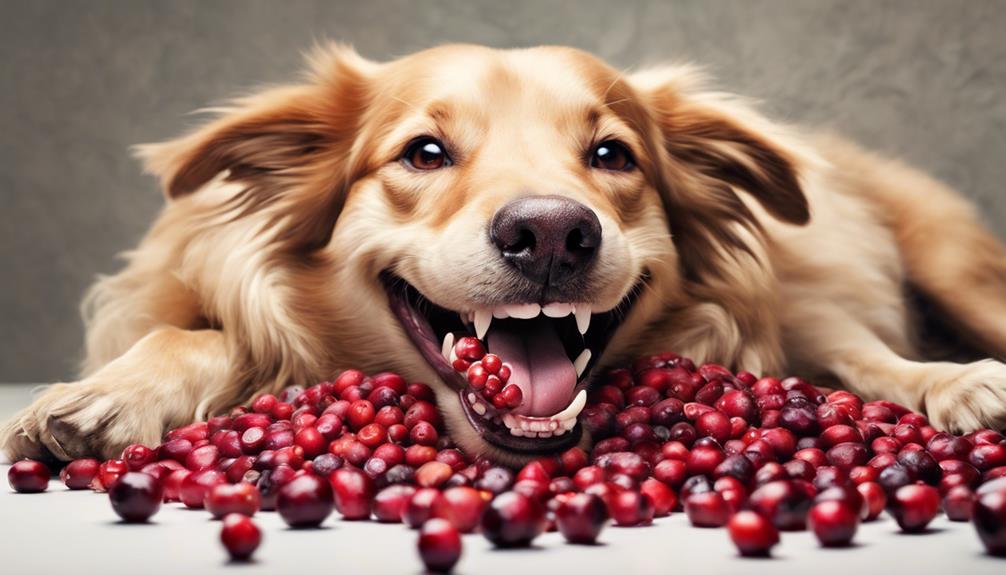
In promoting dental health in dogs, cranberries play a beneficial role by reducing plaque and tartar buildup on their teeth. Here's how cranberries can help your furry friend's oral hygiene:
- Natural Compounds: Cranberries contain natural compounds that can inhibit the growth of bacteria responsible for dental issues in dogs.
- Abrasive Action: Chewing on fresh cranberries provides a mild abrasive action that helps clean your dog's teeth, contributing to better oral health.
- Fresher Breath: Including cranberries in your dog's diet may lead to fresher breath, thanks to their ability to combat bacteria in the mouth.
- Overall Oral Hygiene: Regular consumption of cranberries as part of a balanced diet can support your dog's overall oral hygiene, promoting healthy gums and teeth.
Introducing cranberries into your dog's diet can be a tasty way to enhance their dental health. Consider incorporating these berries into their meals to support fresher breath and cleaner teeth.
Quantity Guidelines for Feeding Cranberries
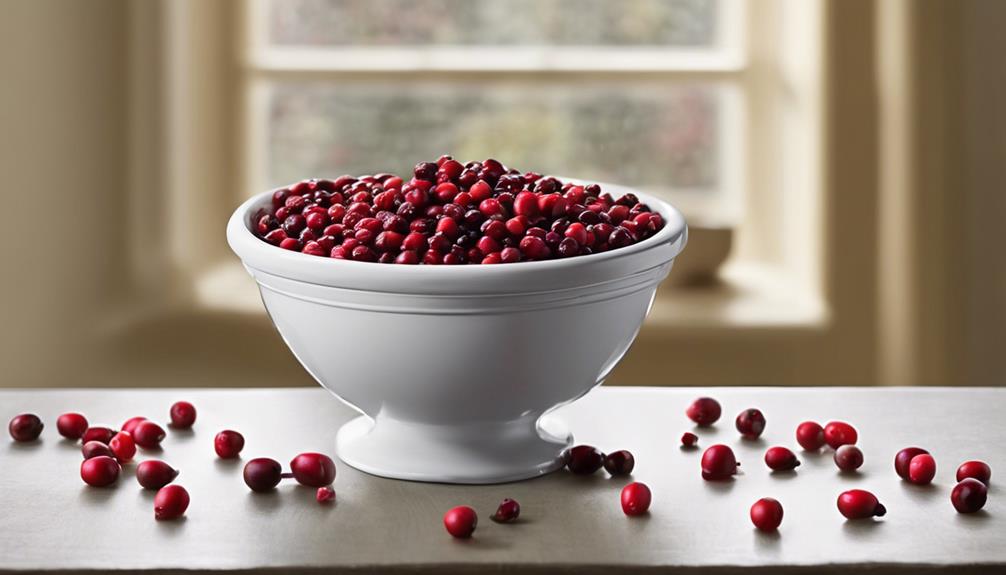
Feeding cranberries to dogs requires careful consideration of appropriate quantities to guarantee their safety and well-being. When it comes to dogs eating cranberries, it's important to feed them in small quantities. Fresh cranberries should be given sparingly to prevent any choking hazards. Dried cranberries can be offered, but make sure to check for added sugars or xylitol content, which can be harmful to your furry friend. Opting for homemade plain cranberry sauce is a safer choice compared to store-bought versions that might contain ingredients not suitable for dogs.
It's vital to monitor your dog for any signs of gastrointestinal distress when introducing cranberries into their diet. Every dog is different, so it's crucial to adjust the quantity of cranberries based on the size of your pet to avoid potential health issues. By feeding cranberries in moderation and being mindful of added sugars, you can make sure that this fruit is safe for your dog to enjoy as an occasional treat.
Choosing Safe Cranberry Products for Dogs
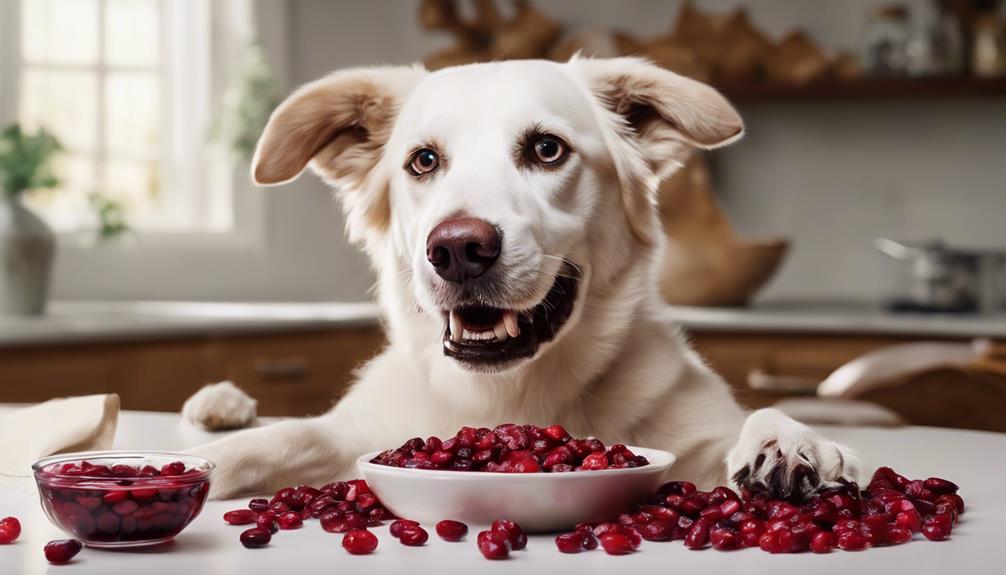
When selecting cranberry products for dogs, prioritize fresh or frozen options to guarantee their safety and well-being. Here are some tips to help you choose safe cranberry products for your furry friend:
- Choose fresh cranberries: Opt for whole fresh cranberries or frozen ones over dried cranberries, as they're less likely to contain harmful additives.
- Check labels carefully: Before purchasing any cranberry products for your dog, make sure to read the labels thoroughly to avoid any harmful additives like added sugars, xylitol, alcohol, or other toxic ingredients.
- Homemade plain cranberry sauce: Consider making your own plain cranberry sauce for your dog instead of buying commercial versions, as this allows you to control the ingredients and ensure its safety.
- Monitor for allergies: Keep an eye on your dog for any signs of gastrointestinal distress or allergies when introducing cranberries into their diet to ensure they're tolerating the fruit well.
The Role of Cranberries in Dog Nutrition

After understanding the importance of choosing safe cranberry products for our dogs, let's explore how cranberries play a significant role in their nutrition. Cranberries are packed with antioxidants, fiber, and essential vitamins, making them a nutritious choice for our canine companions. These little red berries can help prevent urinary tract infections in dogs by stopping harmful bacteria from sticking to the bladder walls. Including cranberries in moderation can also promote overall digestive health and help maintain a balanced gut flora in our furry friends. When it comes to feeding your dog cranberries, opting for fresh or frozen ones is best as they have fewer additives and sugars compared to dried versions. Below is a table summarizing the benefits of cranberries for dogs:
| Benefits for Dogs | Description |
|---|---|
| Prevent UTIs | Cranberries inhibit bacteria attachment in the bladder |
| Digestive Health Support | Fiber in cranberries aids in maintaining gut health |
| Nutrient-Rich Option | Rich in antioxidants and essential vitamins |
Cranberries: Fresh Vs. Dried for Dogs
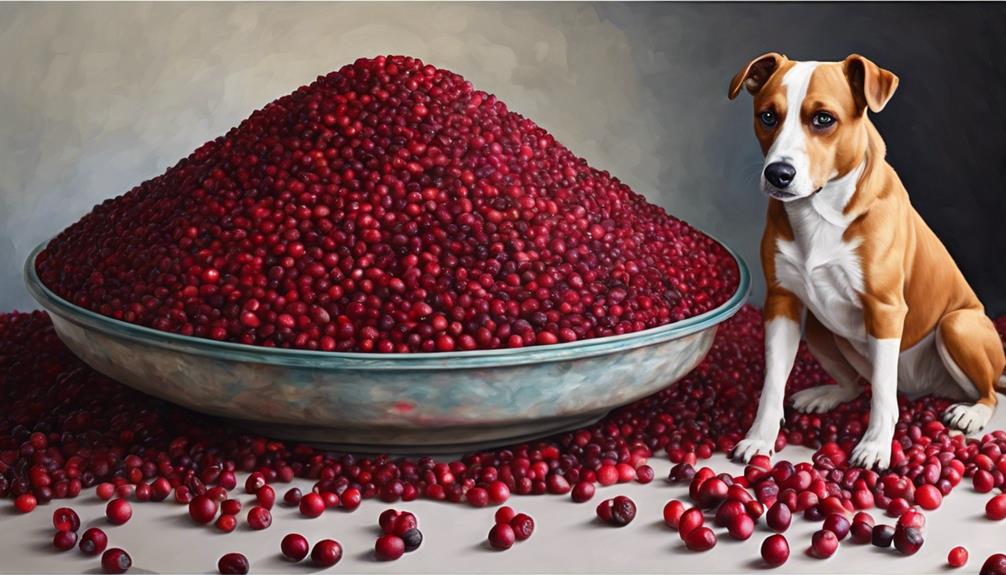
Choosing fresh cranberries over dried ones is recommended for dogs to avoid potential risks associated with added sugars in the latter. When deciding between fresh or dried cranberries for your furry friend, consider the following:
- Safety: Fresh cranberries are safe for dogs and can be given in moderation to prevent any choking hazards, as they contain edible tiny seeds that are safe for consumption.
- Added Sugars: Dried cranberries may have condensed sugar content, so it's important to monitor the amount given to dogs and check for any added sugars or xylitol, which can be harmful to them.
- Portion Control: When offering dried cranberries to dogs, make sure they're given in small portions to prevent overconsumption of sugars and potential digestive issues.
- Nutritional Value: Fresh cranberries retain more of their natural nutrients compared to dried ones, making them a healthier choice for your canine companion.
Incorporating Cranberries Into Your Dogs Diet

To enhance your dog's diet with the benefits of cranberries, we recommend incorporating fresh or frozen cranberries in moderation. Dogs can eat cranberries, and it's a good idea to feed them as they can contribute to your pet's health.
However, it's crucial to avoid feeding cranberry sauce or dried cranberries to your furry friend, as these may contain added sugars or harmful ingredients that could lead to an upset stomach or other issues. Instead, consider incorporating fresh or frozen cranberries into homemade treats for your dog to enjoy.
Before introducing cranberries into your dog's diet, it's always a good practice to consult with a vet to confirm they're suitable for your pet and won't cause any adverse reactions. By being mindful of potential risks and allergies, you can safely incorporate cranberries into your dog's diet to promote their well-being and add variety to their meals.
Frequently Asked Questions
How Much Cranberry Can a Dog Have?
We can offer dogs cranberries in moderation. The recommended amount varies by size: 1-3 for small dogs, 2-5 for medium, and 4-8 for large dogs.
Too many cranberries may cause tummy troubles, so monitor the intake. Adjust based on your dog's size and sensitivities to prevent issues.
Consult your vet to determine the right amount based on health and diet. It's important to maintain a balanced diet that includes other nutrients.
Can Dogs Eat Raw Cranberries?
Yes, dogs can eat raw cranberries. However, caution is necessary, especially for small dogs, as there's a risk of choking.
It's important to supervise your dog while they eat cranberries to prevent any incidents. Consider the size of the cranberries, especially for dogs with dental problems.
Why Can't Dogs Have Canned Cranberry?
We need to steer clear of canned cranberry products for our furry pals. These cans are filled with added sugars, preservatives, and artificial ingredients that spell trouble for dogs.
The high sugar content can pack on the pounds, harm their teeth, and upset their tummies. Plus, artificial sweeteners like xylitol are a no-go zone for dogs.
Stick to fresh or homemade cranberry goodies for a healthier canine treat option.
Can I Give My Dog Cranberries for Urinary Tract Infection?
Yes, dogs can eat cranberries safely for urinary tract infection management. Cranberries contain compounds that may help prevent UTIs in dogs. However, limited scientific evidence confirms their effectiveness.
It's important to consult a vet before giving your dog cranberries. Monitor for any adverse reactions. Cranberries should complement, not replace, veterinary care for UTIs in dogs.
Always prioritize your pet's health and well-being.
Conclusion
In summary, while cranberries can be a healthy snack for dogs in moderation, it's important to be careful of potential risks such as digestive upset. Monitoring your dog after consuming cranberries is essential to guarantee their well-being.
Remember to consult with your veterinarian for guidance on incorporating cranberries into your dog's diet safely. Stay informed and make responsible choices when it comes to your furry friend's nutrition.
